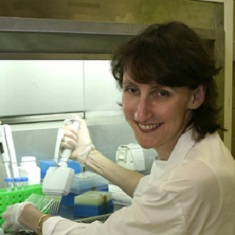Seminar with Professor Elizabeth Gillam
A Dobzhanskian view of P450 form and function: Charting the evolutionary trajectories of xenobiotic-metabolising P450s using ancestral sequence reconstruction
By Visiting Professor Elizabeth Gillam
Elizabeth Gillam
School of Chemistry and Molecular Biosciences
Faculty of Science
The University of Queensland
The xenobiotic-metabolising cytochrome P450 enzymes from the vertebrate CYP1, CYP2 and CYP3 families are distinguished by their generally broad and overlapping substrate specificity. These characteristics suit them well to a role in chemical defence, and it has been hypothesised that animal-plant chemical warfare may have been a major driver behind the evolution and proliferation of these P450 families. We have recently resurrected ancestors of the CYP3 and CYP2D (sub)families and shown that they are markedly more thermostable than the respective extant forms. This result raises a number of questions about the origin of these P450s. Was thermostability a common trait in ancestors of these P450 families? What was the physiological function of ancestral P450s? Did xenobiotic-metabolizing P450s evolve from antecedents that were equally promiscuous, or ancestors that metabolised a defined endogenous substrate? The aim of this study was to explore the evolutionary trajectories of xenobiotic-metabolising P450s. Multiple ancestors of the CYP1, CYP2 and CYP3 families were resurrected from different nodes in the evolutionary tree. Each ancestor was characterized for activity towards typical endo-and xenobiotic substrates of the respective extant descendants. Overall, thermostability correlated with evolutionary age, suggesting that this trait was carried over from P450s that existed in primordial, thermophilic organisms. However certain lineages showed increases in thermostability at specific points in their evolution. Notably, the most evolutionary diverse families were amongst the most thermostable. Qualitative differences were seen in the relative promiscuity of ancestral and extant forms in different families. Whereas the CYP3 ancestor showed similar catalytic activity to human CYP3A4, ancestors of the CYP2D and CYP1 families were less active towards typical substrates than the respective extant forms. By contrast the older ancestors of the CYP2A, CYP2B, CYP2C and CYP2E families were generally more promiscuous than their extant descendants, suggesting a specialisation towards particular classes of substrates during evolution of these subfamilies. Certain evolutionary intermediates of the CYP3 and CYP1 families showed markedly enhanced turnover and altered regioselectivity towards particular substrates, including the production of novel metabolites. Ancestral resurrection allows an exploration of the evolution of structure and function in P450s. Our results suggest that the inherent thermostability of the ancestors of xenobiotic-metabolising P450s may have facilitated the evolutionary diversification of these enzymes. While the ancestral substrates of xenobiotic metabolising P450s are yet to be identified, the major families appear to have followed distinct evolutionary trajectories.
